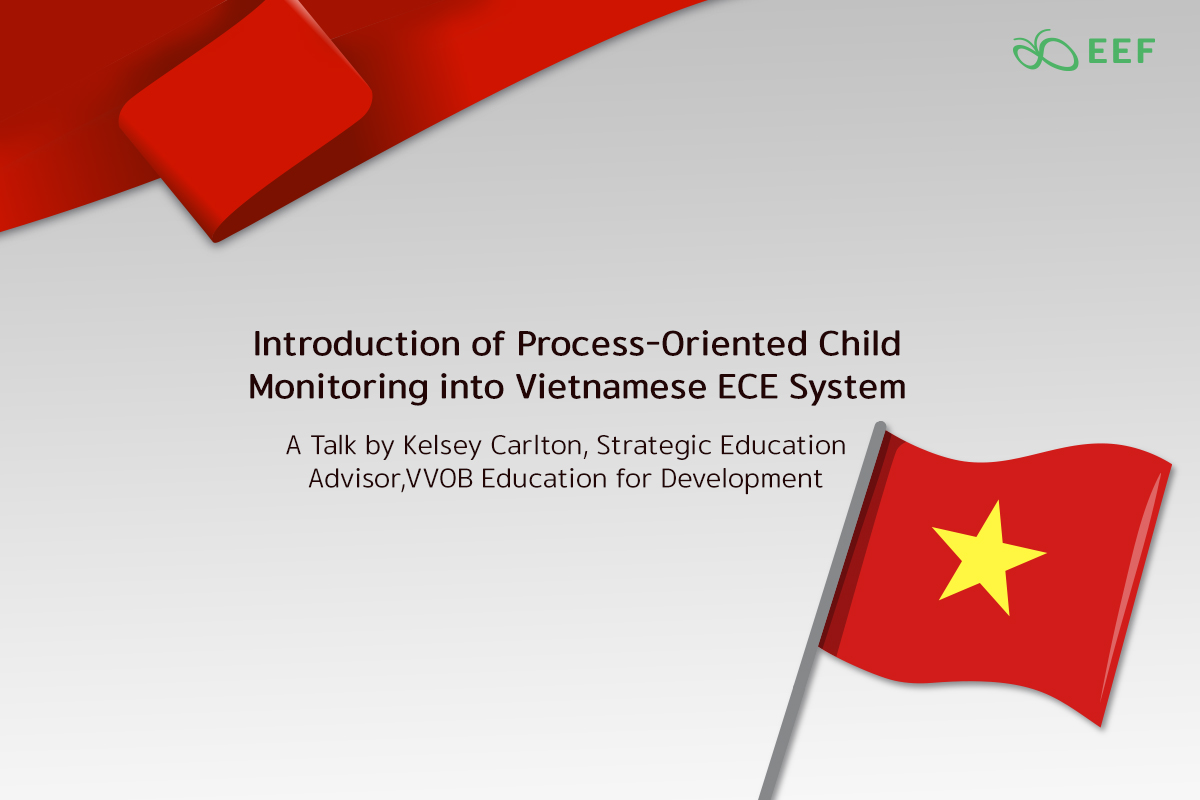
“Over the past two decades, Vietnam has made tremendous strides in expanding access to Early Childhood Education (ECE) through its satellite school model, which has allowed for the establishment of more schools in rural parts of the country,” said Kelsey Carlton, Strategic Education Advisor, VVOB Education for Development, recapped the latest development in the Vietnamese ECE as she set the stage for her talk “Introduction of Process-Oriented Child Monitoring into Vietnamese ECE System” at the 6th Meeting of Equitable Education Alliance: Exercising Equity to Deliver An Inclusive Classroom on February 7th, 2023.
However, as the advisor proceeded, the focus shifted from access to quality; The challenge is to ensure that all children are given equitable opportunities, and teachers — are equipped with the skill set to support them. To meet this challenge, VVOB is supporting the government in empowering preschool teachers with the competencies necessary to effectively identify and address any underlying issues that may impede children’s learning, thus providing them with a more equitable learning environment where all children in the classroom are learning at the same rate.
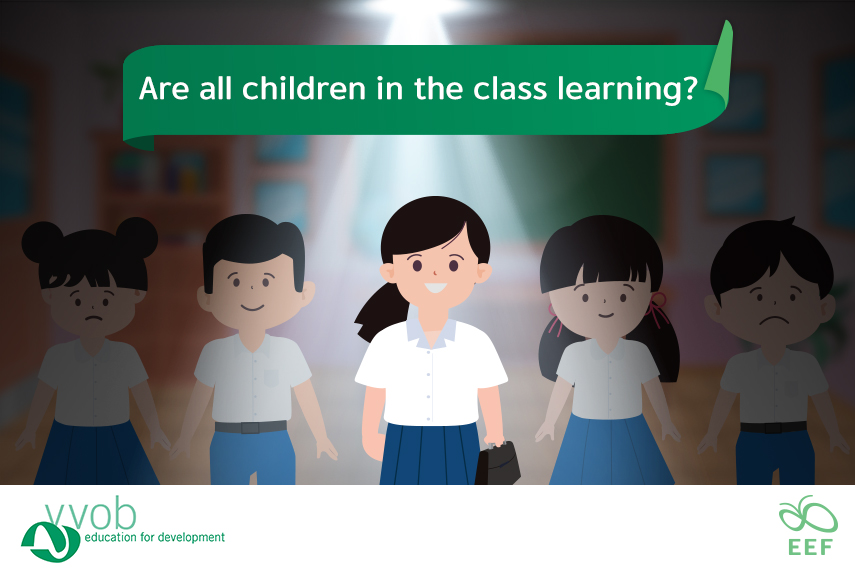
Unfortunately, this is not the case here; As Carlton corroborated, citing VVOB’s research and the government’s documents, despite some improvements in enrollment rate, particularly among the ethnic minority children already living in the country, there are inequities between those who speak only Vietnamese at home and those who may speak an ethnic minority language or have a multilingual school background. With that being said, she then proceeded to share that to tackle this problem, Process-Oriented Child Monitoring (POM) has been implemented, and it has thus far been successful in ensuring all children in the classroom are learning at the same rate, especially in the Vietnamese ECE system.
In elaborating on this, the advisor first highlighted the need to move away from a one-size-fits-all type of model when it comes to teaching. She argued that one specific method may not always be successful in ensuring all children are learning at the same rate, and as such, teachers should be made aware of this and be educated on how to adjust their approaches depending on learning objectives. She then noted that there has been a focus on implementing a child-centered approach in Vietnam, yet there is a lack of clarity on what such an approach entails and how teachers can put it into action. A prerequisite to addressing this, as she concluded, is opening up this conversation, which is the first step in initiating the POM initiative.
Simply put, POM is a system of observation, reflection, and taking action in the classroom. It revolves around two important concepts: well-being and involvement, both of which have a direct impact on children’s learning; Studies demonstrate that the higher the levels of these two aspects, the deeper the level of learning and holistic development in children. Carlton argued that only through intentional and focused child observation can teachers determine whether children are exhibiting high levels of well-being and involvement and if not, then discern why and take necessary actions to boost those levels.
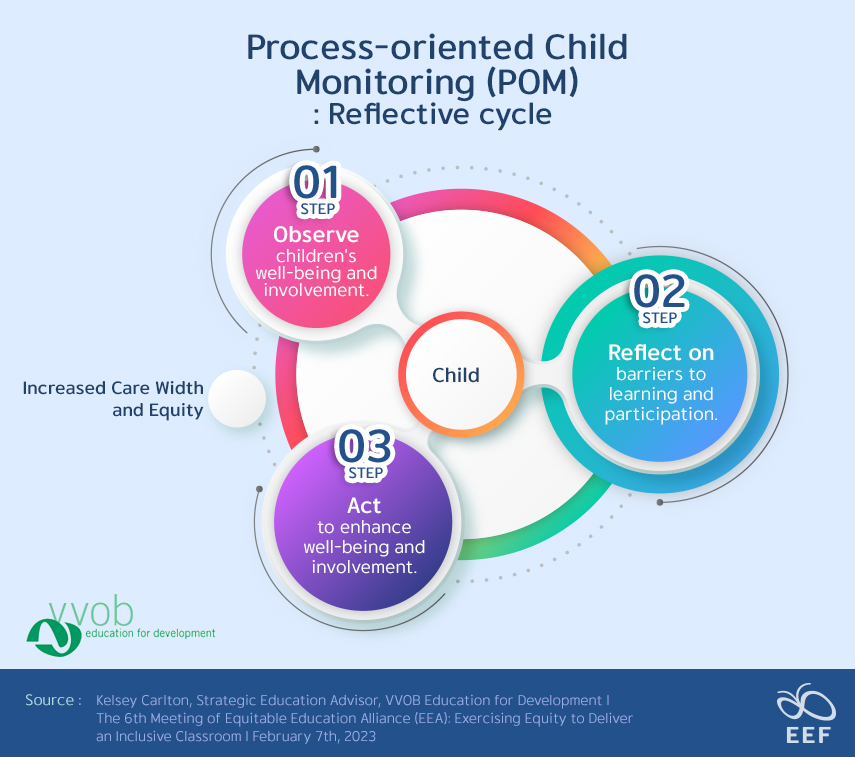
POM is a reflective cycle where teachers constantly assess and re-assess the impact of their teaching on children’s well-being and involvement. By observing how children are engaging in the classroom, reflecting on what potential barriers may be preventing them from learning and participating, and then acting to enhance their well-being and involvement, teachers can make real-time adjustments to best support their children, instead of just trying new approaches all the time and not knowing which one works and which one does not. The advisor asserted that this is an entirely novel approach to teaching in Vietnam and has the potential to revolutionize the way teachers interact with their children.
From the aforementioned, children’s well-being and involvement in the classroom should be a major priority for teachers, but many of them may not understand what each of the terms actually entails or how to increase their levels within their control. To ensure the best outcome for children, Carlton suggested teachers understand what these two variables are and be equipped with evidence-based practices that can help them focus on what is within their control.
In POM, children’s well-being is referred to as their pleasure and enjoyment, self-confidence, and self-esteem in the classroom, while children’s involvement is deep concentration and satisfaction, high interest and motivation in the classroom. The advisor, as opposed to just measuring results, can bring about a deep level of learning. Furthermore, she asserted that they are relevant for every developmental domain and can be used in any content area to have a lasting impact on holistic early childhood development, as she proceeded to put a further emphasis on their significance.
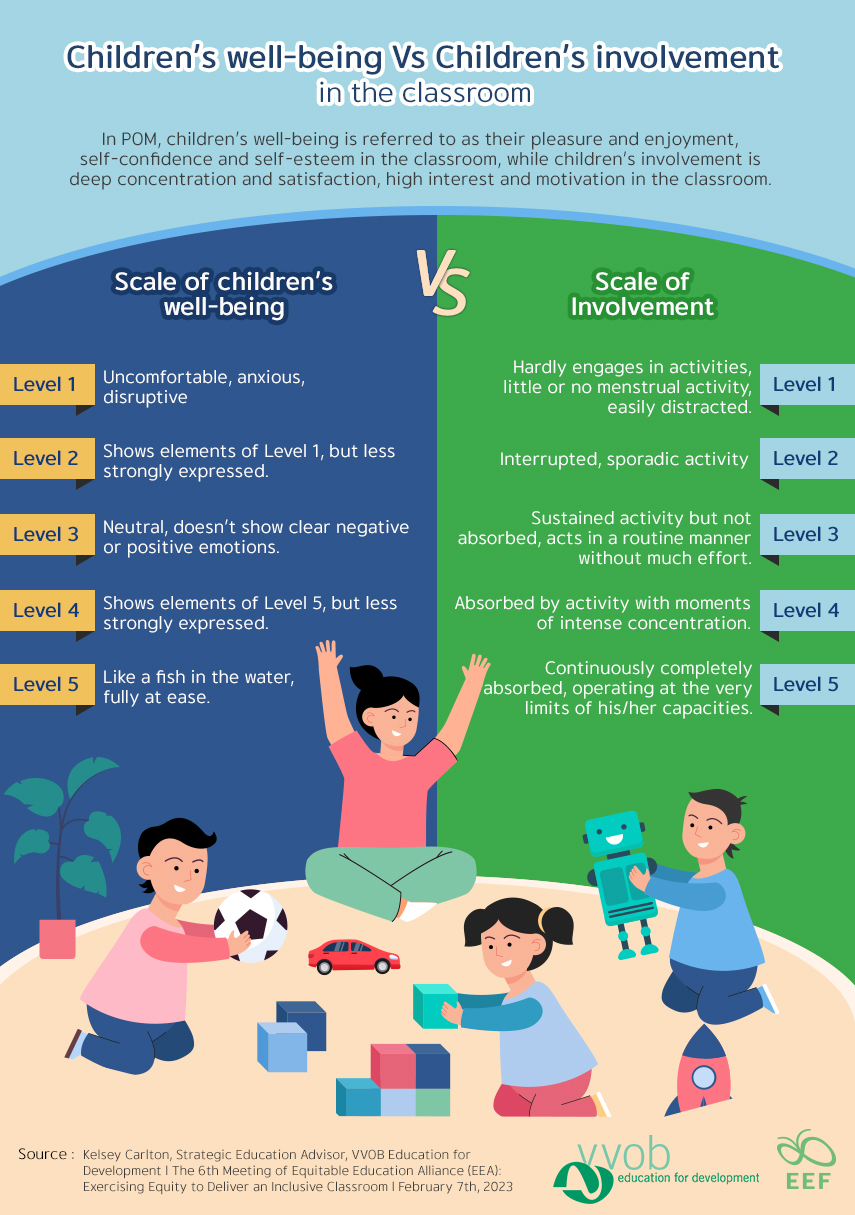
Children’s well-being Vs Children’s involvement in the classroom
In POM, children’s well-being is referred to as their pleasure and enjoyment, self-confidence and self-esteem in the classroom, while children’s involvement is deep concentration and satisfaction, high interest and motivation in the classroom.
Scale of children’s well-being
Level 1: Uncomfortable, anxious, disruptive
Level 2: Shows elements of Level 1, but less strongly expressed.
Level 3: Neutral, doesn’t show clear negative or positive emotions.
Level 4: Shows elements of Level 5, but less strongly expressed.ฅ
Level 5: Like a fish in the water, fully at ease.
Scale of Involvement
Level 1: Hardly engages in activities, little or no menstrual activity, easily distracted
Level 2: Interrupted, sporadic activity
Level 3: Sustained activity but not absorbed, acts in a routine manner without much effort.
Level 4: Absorbed by activity with moments of intense concentration.
Level 5: Continuously completely absorbed, operating at the very limits of his/her capacities.
Although these process variables are quite subjective, elusive, and variable, given that they can alter rapidly — from day to day, even from hour to hour, their scales do help teachers keep track of children’s progress over time. Carlton shared that once teachers become more skilled in employing them in measuring the variables over the course of days, weeks, and months, they can gain a better understanding of a child’s overall state of well-being and involvement in the classroom, and thereby identify children that may be experiencing low levels of well-being and/or involvement.
After carefully observing, teachers can then reflect on any potential barrier that may be hindering children’s well-being and involvement. Some of the possible barriers that are commonly seen are language barriers, social interactions, mismatched interests, and activities that are too easy or hard for children. Once identify the barriers, they can then act to address them individually.
The advisor notes that teachers should be aware that there might be multiple barriers happening at one time, and the best approach is to focus on one at a time. The POM materials provide eight Action Points to help teachers identify what is the best solution for their particular classrooms. By zeroing in on a specific barrier and adapting an Action Point accordingly, teachers can ensure that their children receive the help they need. The eight Action Points include:
Action Points
-CLASSROOM
- Rearrange the classroom in appealing corners or areas;
-IN-CLASS MATERIAL & ACTIVITY
- Check corners to replace unattractive materials with more appealing ones;
- Introduce new and unconventional materials and activities;
- Discover children’s interests and find related activities;
- Support ongoing activities with stimulating impulses and enriching interventions;
- Widen possibilities for free initiative & Support them with sound rules and agreements;
-SOCIAL INTERACTION
- Explore and improve the relationship with each child and between children;
- Introduce activities that help children to explore the world of behaviors, feelings, and values.
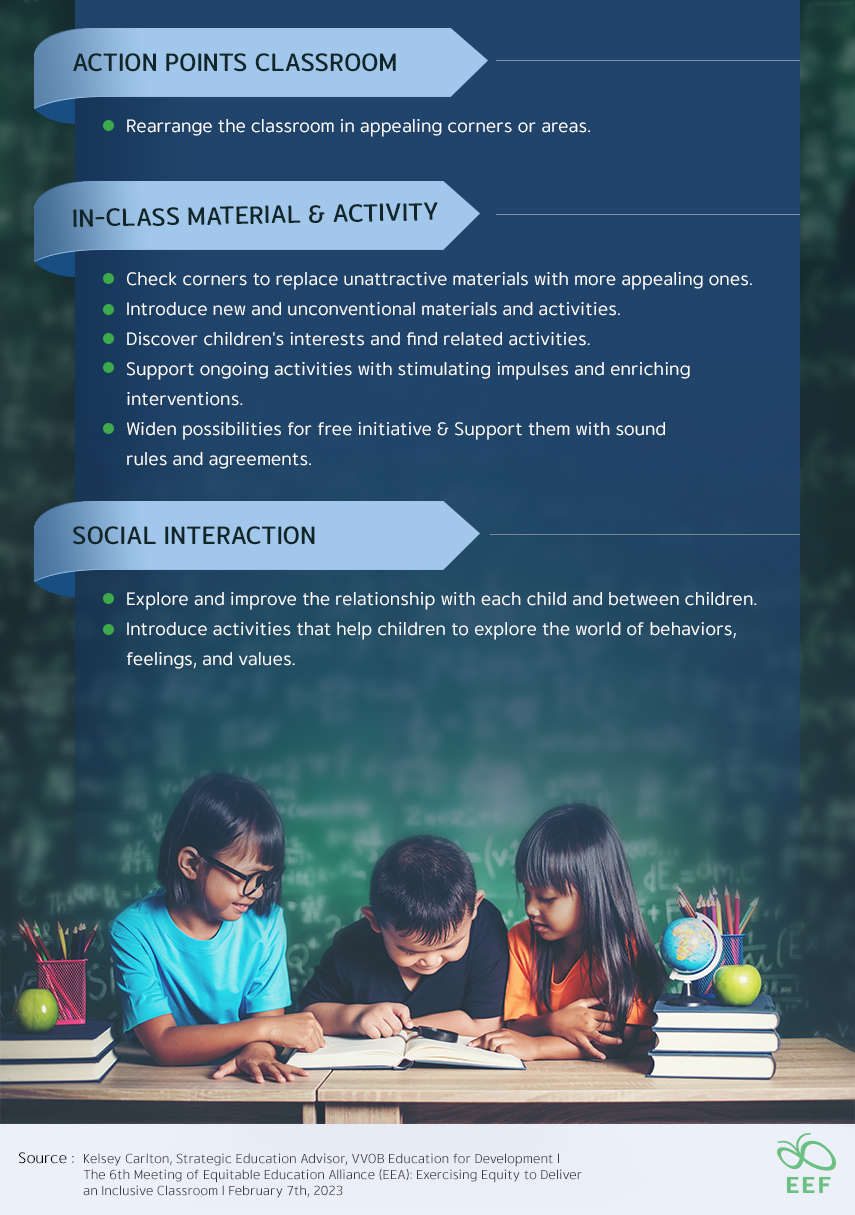
This is a great starting point to get teachers into the habit of observing, reflecting, and taking action. As they grow in proficiency, they can expand on these Action Points, making them more tailored and contextualized for their classrooms. In the POM materials, there is a wealth of more specific Action Points, with visuals of how to do it, reasons for why to do it in a certain way versus another, as well as the advantages of doing so.
“VVOB is striving to promote a reflective teacher mindset — one that continuously evaluates their own practices and interactions with their children during the learning process, rather than merely looking at the end result, and this three-step cycle is designed to help cultivate this type of teacher,” remarked Carlton as she proceeded to cap off her talk by summing up all that has been accomplished by POM and what lies ahead of it.
POM, piloted and adopted with VVOB and its government partners in 2015, proved successful and was endorsed by the Vietnamese Ministry of Education’s endorsement. Capitalizing on ECE teachers’ existing task — daily observation of children — that was not yielding any results, POM provided the teachers with a systematic, intentional way to use these observations to improve their practices. Seen as a way to do part of their job in a better and more intentional way and in line with the child-centered approach, rather than an additional task, it fits easily into the current policies and provided teachers with tangible outcomes.
POM has been used as a foundation for VVOB’s further programs in an effort to expand its evidence base; Initial evidence had been gained, yet more data was necessary, as was the case with an expansion of the research locations and scales to assess the system in different contexts. There were two impact studies of POM, uncovering the need for further intervention. The first shows that there were significant improvements in the overall scores across the East Asia Pacific region, as well as changes in socio-emotional development and health behavior among both genders.
However, the second shows otherwise; Ethnic minority children in the new provinces where VVOB would be working were still performing significantly lower than the national average across six of the seven domain areas, highlighting that the government’s child-centered approach and focus on ethnic minorities have yet to make a difference in certain areas. To close the gap, POM will be combined with a language program in these provinces. In 2025, a follow-up study will be carried out to assess the effectiveness of POM.
Since 1982, VVOB Education for Development has been empowering governments to provide quality education for everyone in eight partner countries, including Vietnam where it started operating in 1992. The non-profit organization has since been promoting capacity development for the country to ensure that the right to quality education is respected, protected, and fulfilled for all learners without any form of discrimination. To achieve this, VVOB has developed multi-year programs in nine provinces, with a focus being placed on Early Child Education System (ECE), Process-Oriented Child Monitoring (POM), and Equitable Education for Minority Populations. The organization views quality education as the foundation for development and works collaboratively with the government and local authorities at the provincial and district levels to ensure that the program is sustainable and tailored to the needs of the community.
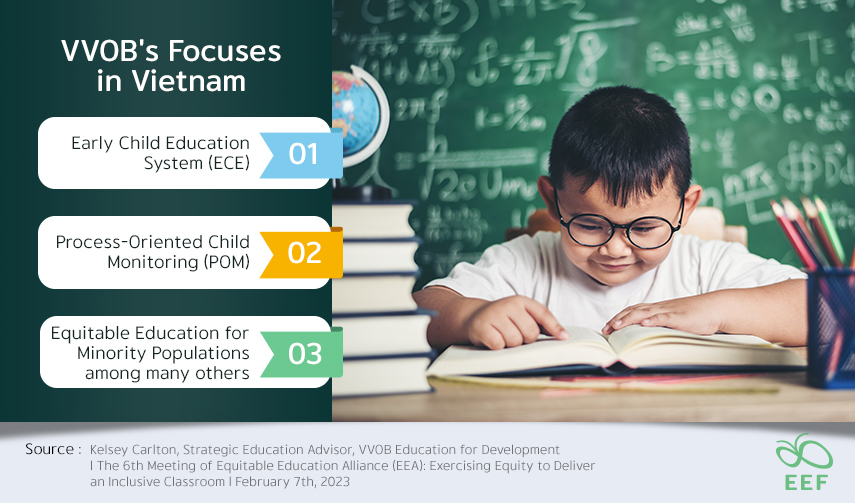
VVOB’s Focuses in Vietnam:
- Early Child Education System (ECE);
- Process-Oriented Child Monitoring (POM);
- Equitable Education for Minority Populations; among many others,
This is in line with the mission of the Equitable Education Fund (EEF) Thailand, which is to reduce education inequality through research, collaboration, and support for children, youth, and adults in need.
Source:
- Record of meeting – The 6th Meeting of Equitable Education Alliance (EEA): Exercising Equity to Deliver an Inclusive Classroom
- Equitable Education Alliance – Equity ED Hub
- Kelsey Carlton, Strategic Education Advisor, VVOB Education for Development l The 6th Meeting of Equitable Education Alliance (EEA): Exercising Equity to Deliver an Inclusive Classroom l February 7th, 2023

